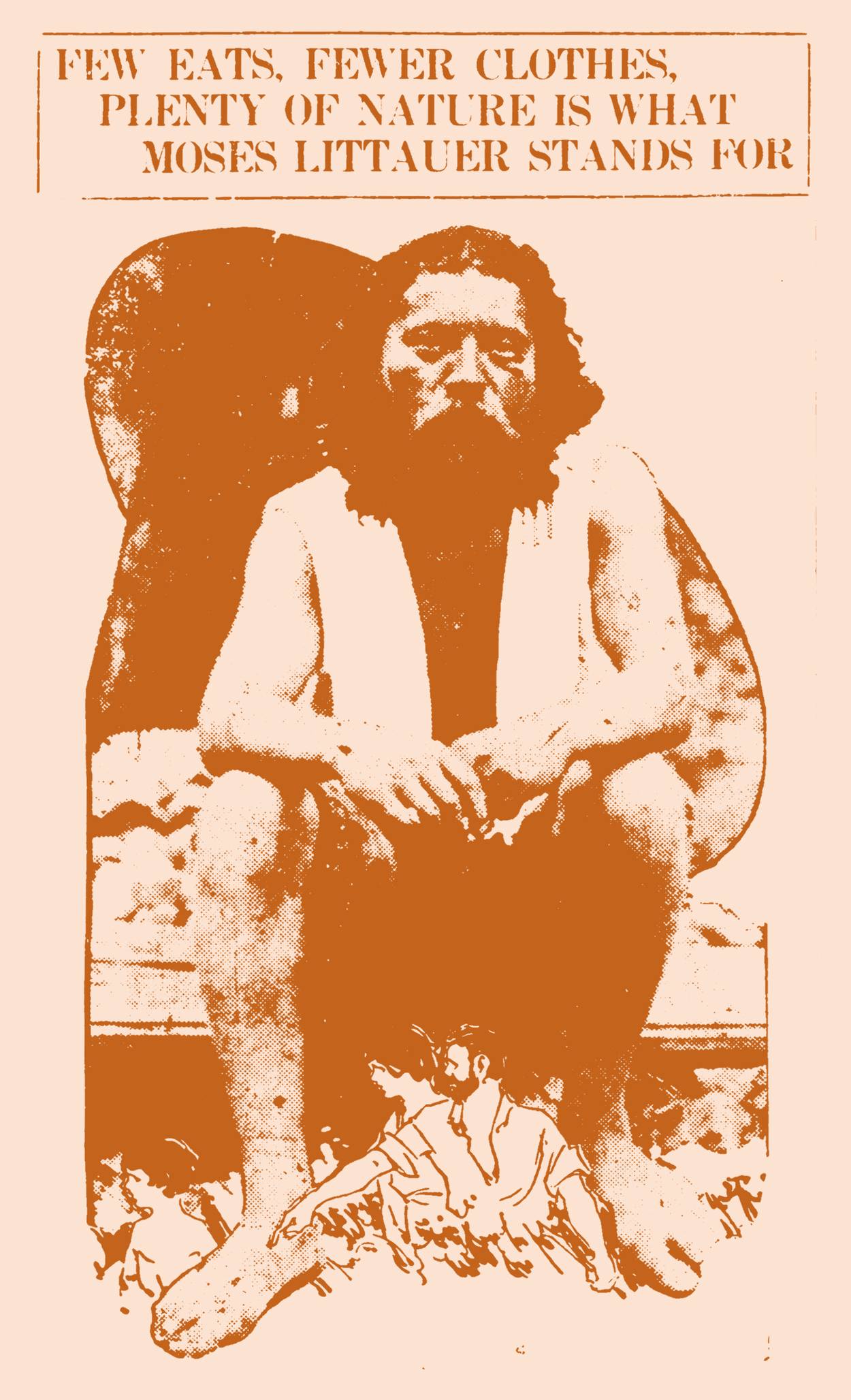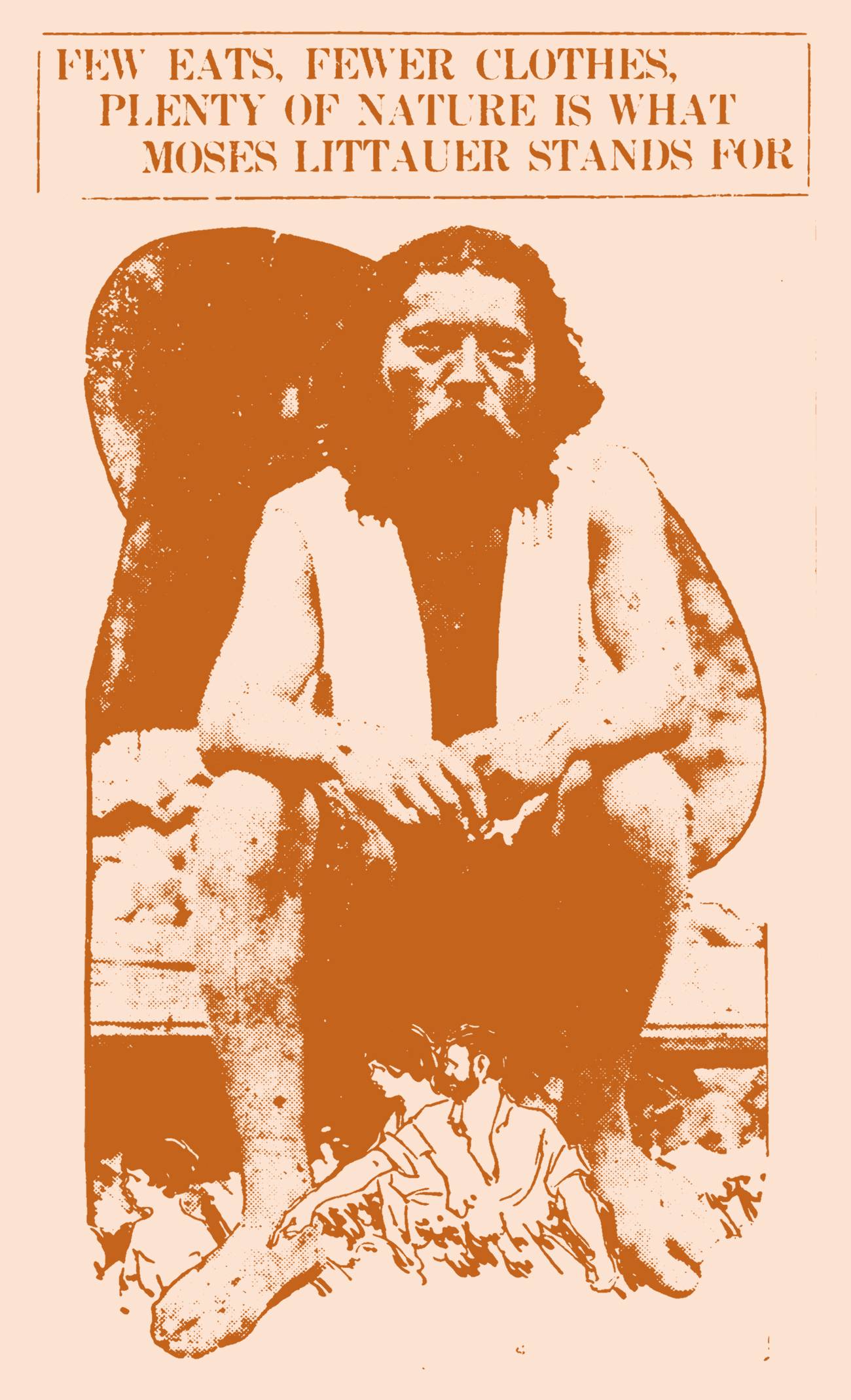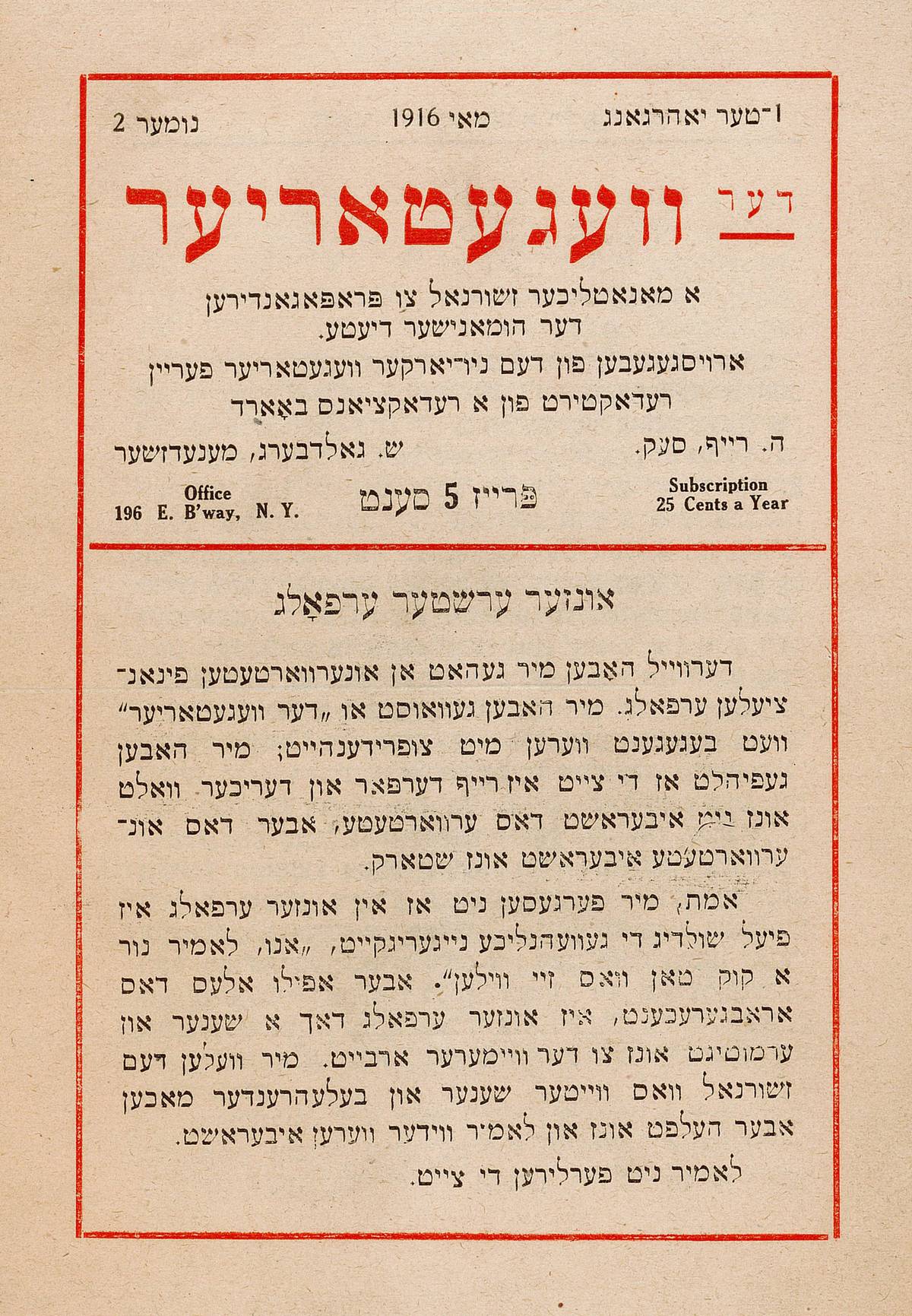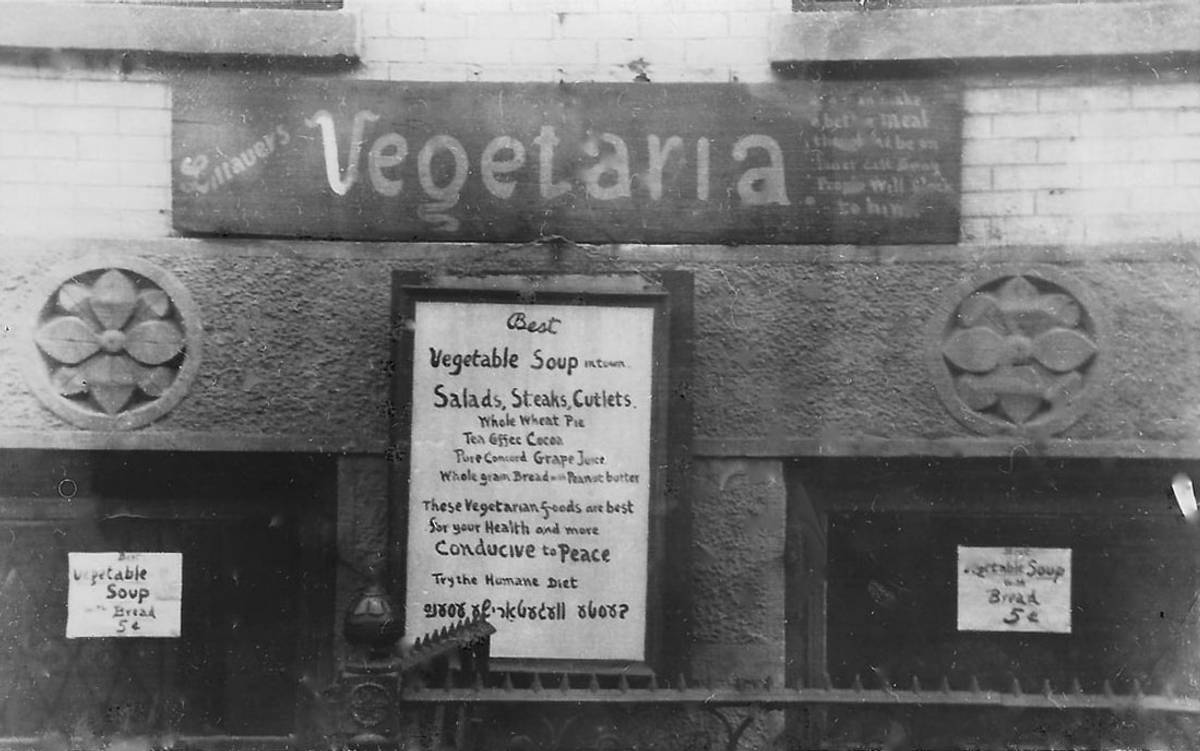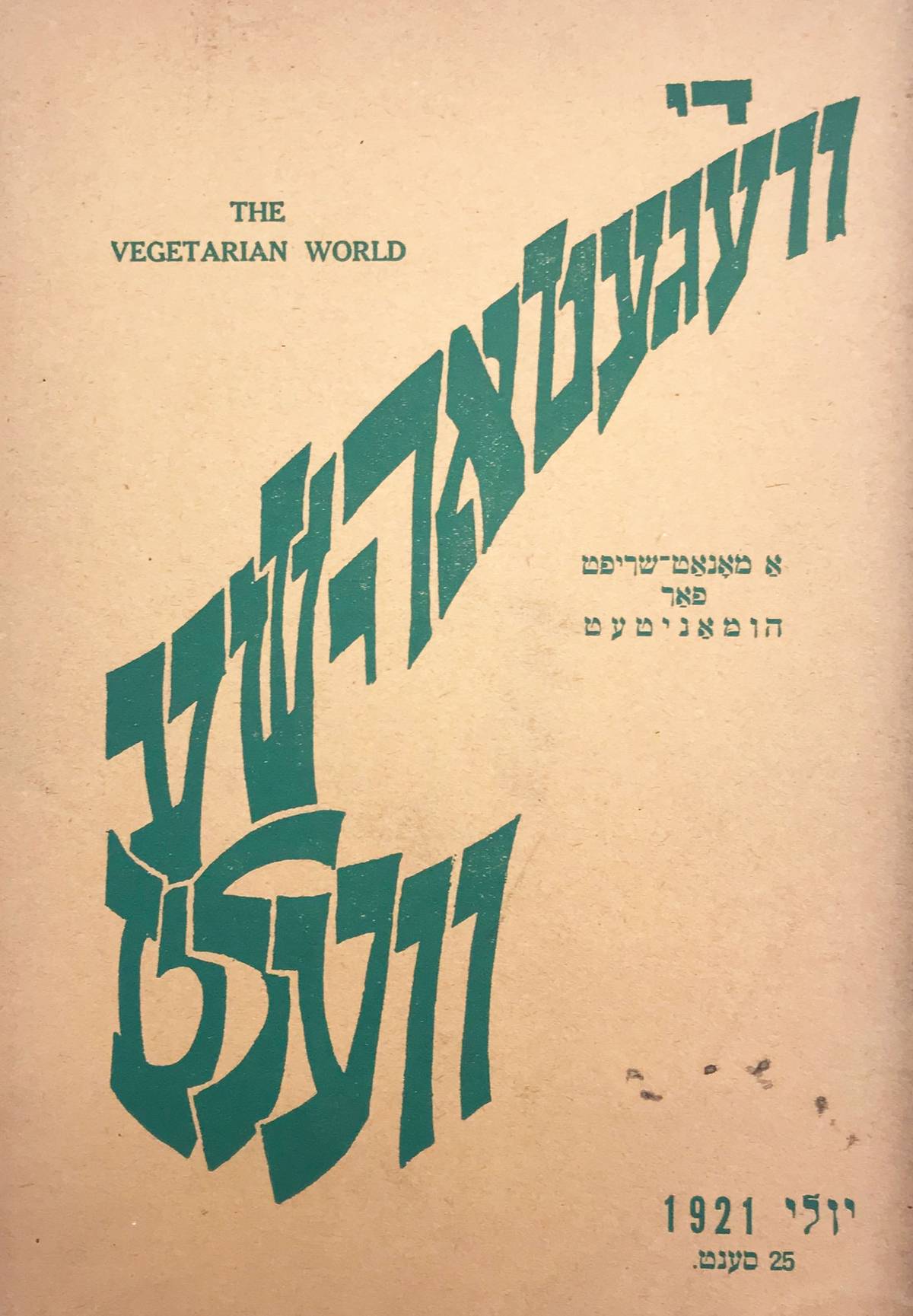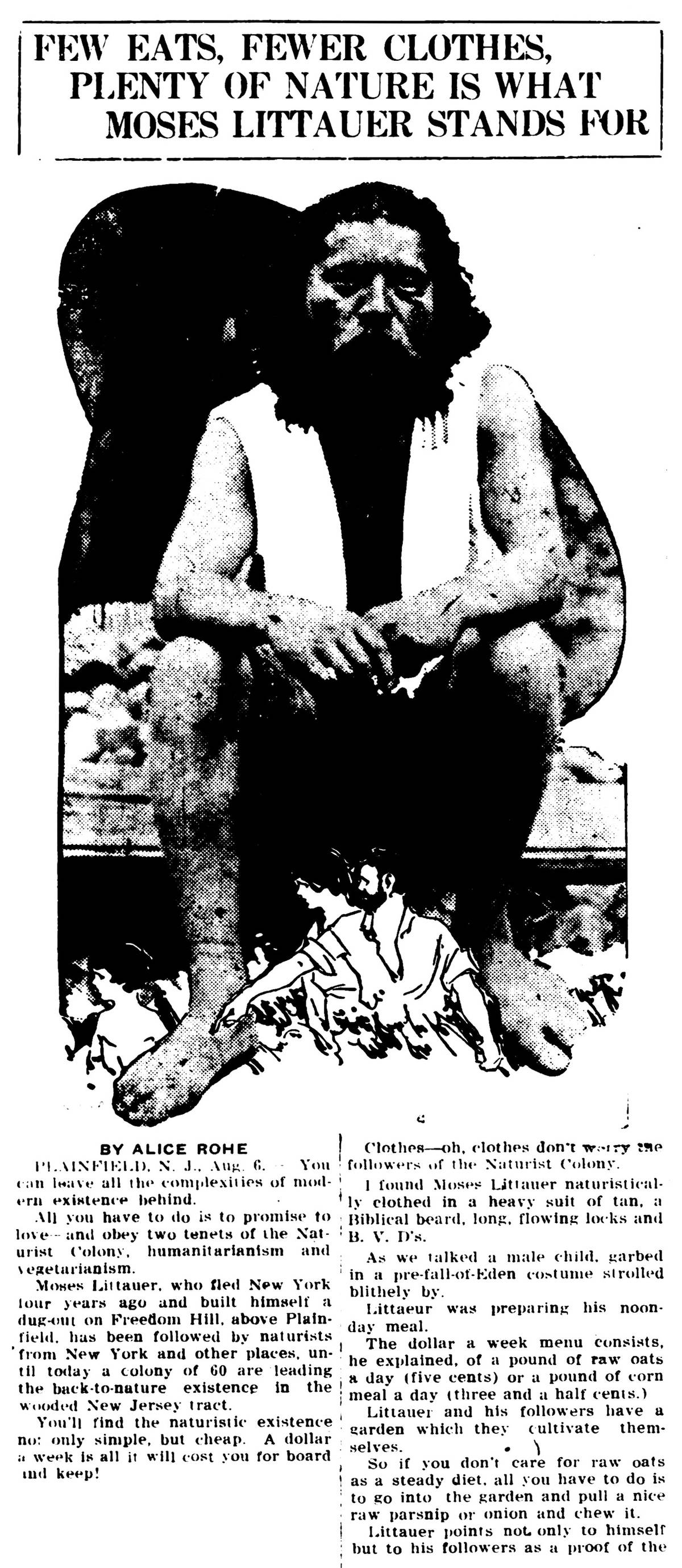“Nutose and Protose,” two forms of early-20th-century vegan meat, is the name of a story written in 1919 by Moyshe Nadir, one of the leading lights of early-20th-century Yiddish satire. A jailhouse confessional narrated by a man driven insane by an annoying waiter in a Lower East Side vegetarian restaurant, the story is an absurd but funny piece in which the narrator is persuaded to eat at a vegetarian restaurant after being accosted by a bizarre man hawking pamphlets on the street. To wit:
A guy with long hair, a scraggly beard, and sporting a pair of canvas pants sidles up to me on the street and asks if I eat meat.
“Sure,” I tell him. “So what?”
“So you’re a cannibal!” he says. “You’re digging your grave with your own teeth.”
“Cannibal-shmannibal, grave-shmave,” I say, “what are you babbling about?” “As long as a man is alive,” I tell him, “he’s got to eat a good piece of meat.
“Your stomach is a graveyard,” he says. “And the blood of fat, innocent chickens will pour down over your head.”
“You’re nuts!” I tell him.
“I’m crazy?” he laughs, “Ha! The people who say I’m crazy are the crazy ones. … Anyway, give me thirty cents and I’ll give you a pamphlet that explains our ideas.”
“For thirty cents I can get a good tenderloin,” I say.
“Gimme seventy cents,” he says, “and I’ll give you another pamphlet that proves that people who eat meat die young from a type of blood poisoning that’s produced in the stomach. Take a look at this picture.”
He shows me a picture of a dead body with a steak hanging out of its mouth.
Even though the whole thing was kind of fishy, I buy two pamphlets, only to discover that meat is deathly poisonous and that there’s only one thing in the world that can be compared to it, but because it’s considered so strong of a poison, even chemists are banned from dealing with it. And then I find out from the same pamphlet that the best food you can find is available at Wormkroyt’s Vegetarian Restaurant, along with all kinds of other vegetarian brochures—and for cheap.
—Excerpt from “Nutose and Protose” by Moyshe Nadir, 1919
Nadir’s story, which ends with the man killing an extremely irritating waiter in Wormkroyt’s Vegetarian, is clearly fictional. It turns out, however, that the man in the canvas pants, hard-selling vegetarian pamphlets, was based on a real person who was even more peculiar in real life than in Nadir’s portrayal.
That person was Moyshe Yitzhok Littauer, who, among other things, founded a vegetarian nudist colony in New Jersey to which he and a group of about 60 Jewish immigrants decamped in 1917 to escape the stifling tenements of the Lower East Side, and where they communed with nature, ate vegetables, and got naked.
But before he arrived at the wonders of nature, nudity, and vegetarianism, Littauer’s story in America begins much like many other Jewish immigrants of that era. Born in the shtetl of Mishenits (Myszyniec) in what was then Russian-ruled Poland, he immigrated as a teenager to the United States in 1899. At first, he found work toiling in New York’s Lower East Side sweatshops, though he eventually saved enough money to start a business as a coffee wholesaler and later managed to open a small grocery. He also got involved with some of the left-wing movements that became part of the fabric of the Jewish Lower East Side during the first decades of the 20th century.
YIVO Library‘Der vegetaryer,’ May 1916
Littauer ultimately found his home in the vegetarian wing of the anarchist movement. In spite of any success he may have had hawking java or selling groceries, he decided to give up commercial pursuits in order to dedicate himself to the vegetarian cause. And while it’s not generally considered among the multiple “isms” to which immigrant Jews attached themselves in the early 20th century, vegetarianism was not an insignificant movement in Yiddish-speaking New York. According to Yiddish journalist A.M. Shtiglitz, vegetarianism attracted thousands of young Jews, many of whom saw it as a revolt against materialism. Jewish immigrants of this era founded a number of different vegetarian organizations and produced a variety of magazines and pamphlets designed to draw the Yiddish audience to meatless fare. The philosophy of anarcho-naturism, of which vegetarianism was a component, also appealed to immigrant Jews on the Lower East Side, among whom anarchism had been a nominally popular political ideology since the late 1880s.
Known as the “Ghandi of East Broadway,” Littauer grew out his hair and beard just before World War I and began to saunter about New York’s Jewish quarter wearing white robes and sandals, preaching the benefits of his chosen diet. With a deep interest in mysticism and Buddhism, he also had an aversion to modern technology and refused to take the subway or streetcars, and always went by foot.
But it wasn’t easy to make a living as an itinerant vegetarian preacher on the Lower East Side, so Littauer found a job managing the Progressive Vegetarian Restaurant on the corner of Norfolk and Grand streets, the motto of which was, “For humane beings, try the humane diet.” As Ben Katchor notes in his hefty tome on the history of the dairy restaurant, the owner’s name was Meyer Litheron, though Littauer, an irrepressible sort, appears to have taken it upon himself to change the name of the place in 1913 to the Pythagoran (Vegetarian) Restaurant.
Not only responsible for the famed a2 + b2 = c2 theorem, the Greek scholar Pythagoras was a vegetarian and an important philosophical influence on the early-20th-century vegetarian movement. Evidently, he also became an avatar for Yiddish-speaking vegetarians. Ever the assiduous advocate for the cause, Littauer advertised free, “bloodless” cooking classes at the Pythagoran in the anarchist weekly Fraye arbeter shtime (Free Voice of Labor) and placed ads for the restaurant in Di froyen velt (The Women’s World) under the headline, “Meat Is Unhealthy.”
Together with his wife, Harriet, who was also his cousin and a contributor of vegetarian recipes to Di froyen velt, he subsequently opened another vegetarian restaurant on Essex Street called Littauer’s Vegetaria. According to one patron, the walls of the place were adorned with pro-veg quotes from the Bible, the Talmud, Pythagoras, Tolstoy, as well as a number of Yiddish writers he favored. On Saturday nights at the Vegetaria, Moyshe Littauer himself could be found giving edifying lectures on the evils of animal slaughter and virtues of vegetarianism. Regarded as a captivating speaker, he always drew a crowd. A.M. Shtiglitz commented in Der tog that he had a kind of “mystical magnetism” that helped him attract a circle of “mostly female” devotees.
Perhaps on account of the long hair and white robes, Littauer was perceived as an eccentric, even among the Lower East Side’s vegetarian anarchist crowd. His writings, however, did manage to earn him a bit of grudging respect among the Yiddish literati. Critic and essayist, Eliyohu Almi noted that he was an excellent writer and claimed that Littauer’s essays on Emerson and Thoreau were among the best on the two American thinkers in any language. It’s unclear how much expertise Almi actually had on Emerson and Thoreau, but it was still a nice compliment.
Littauer’s Vegetaria, undated photo by David Richard KirshnerCourtesy of Jayne Loader and Richard Kirshner
In addition to his occasional contributions to anarchist and vegetarian Yiddish newspapers, Littauer was also a publisher of pamphlets that ranged in topic from the Indian scholar Rabindranath Tagore to his thoughts on the death penalty (he was against it). Opposed to the concept of copyright, Littauer often wrote “reprinting not prohibited” on his publications, and also didn’t mind simply giving them away for free; under “price” he would sometimes print, “from nothing to extremely high” on the front of his booklets.
In his memoirs, Almi recounts how one vegetarian restaurateur, Herman Schildkraut, would organize open air meetings on the Lower East Side during which speakers stood on soap boxes and expounded on the virtues of vegetarianism to crowds of immigrant Jews. Some locals, however, expressed their disagreement with the vegetarians by dumping slop buckets on their heads.
While no vegetarian riots ever ensued as a result of the occasional attacks on their public meetings, some of the Yiddishist anarcho-vegetarians were extremists. Almi mentions that one he knew argued fervently that slaughterhouses and butcher shops should be blown up and that butchers should be killed.
Most Yiddish vegetarians, however, were not of the murdering, bomb-throwing sort. Littauer and his ilk were regarded as calm, reasonable, and inviting. Almi recounts a story about Littauer in which he was accosted by an obnoxious young man in the street who, upon seeing this strange, white-robed figure, began to yank on Littauer’s long hair and beard. Instead of reacting angrily to the assault, Littauer spoke calmly to the young man and handed him his card, telling him to come to his restaurant. After a few words with Littauer, the young man burst into tears and apologized for his brutal outburst. From that day on, he could be found eating in Littauer’s restaurant, a regular.
Having spent his childhood in a small town in the Polish countryside, Littauer came to understand that the crowded, grimy tenements of the Lower East Side were hardly conducive to a healthy lifestyle, even if you stuck to a vegetarian diet. So, he plotted his escape. Taking about 60 adherents with him, he moved, in 1917, to a woodsy colony just outside of Plainfield, New Jersey, where he and his acolytes could live the healthful lifestyle they desired.
‘Di vegetarishe velt,’ July 1921YIVO Library
Taking up residence on a forested plot of land above the town called Freedom Hill, Littauer and his followers ate a lot of raw foods and kept their clothing to a minimum. Locals thought they were a bit odd and spread a rumor that the group practiced free love, a matter they didn’t exactly deny. The Yiddish journalist A.M. Shtiglitz paid a visit to the colony and described one evening’s activity as sitting around a campfire upon which a large pot of beans was bubbling, while Littauer, clad only in a loincloth, expounded upon the virtues of nature and of vegetarianism. His followers, Shtiglitz wrote, eagerly ate up his words—along with the beans.
Although Littauer’s colony was investigated in 1921 by local police on charges of public nudity, nothing ever came of it. When asked, Littauer commented that the colony’s members kept to their own property when going about “as nature intended.” Moreover, he added, “Clothing is bad for the health. A healthy skin cannot live all bound up.” The episode generated interest on the part of journalists, who produced a number of articles that brought nationwide attention to the small colony of Yiddish nudists.
These articles portrayed Littauer as somewhat of an exotic figure but noted that anyone could join the colony as long as they adhered to two tenets—humanitarianism and vegetarianism. Nudism, although mentioned, was optional and it seemed that colonists wore some clothing when outsiders were present. The essential point that Littauer stressed to curious journalists was not nudism but vegetarianism, which, he said was not only beneficial for one’s health, but was also a financial boon because it cost only a dollar a week to eat his prescribed diet, which consisted mainly of raw oats or corn and an occasional parsnip. One syndicated article, titled “Like Cave Dwellers of the Past,” appeared in dozens of newspapers throughout the U.S. in early August 1921, and claimed that the colony’s denizens lived “as the primitive ancestors of the human race.”
While it’s not generally considered among the multiple ‘isms’ to which immigrant Jews attached themselves in the early 20th century, vegetarianism was not an insignificant movement in Yiddish-speaking New York.
In the wake of this publicity, Daniel Persky, a journalist for the Yiddish daily Yidishes tageblat, suspected something was amiss and paid a visit to the colony in order to provide what appears to be a more accurate assessment than the journalists of the English language press had offered. The ideology of the colony, he wrote, was essentially the same as that of Jean-Jacques Rousseau and Leo Tolstoy, only more Jewish. According to Persky, the interests of the colonists were mainly moral and they simply wished to bring no harm to animals by eating either them or their products. In addition to hewing to strict vegetarian fare, we also learn that fasting was a common practice in the colony. Littauer told Persky that he once fasted for 30 days straight and also made the astonishing claim that, one day in the future, humans will eventually stop eating entirely and would obtain nourishment from the air alone. But, until that time, he and the colonists would stick to vegetables.
Persky’s report indicates that nearly everyone in the colony was Jewish, with the exception of two people—an Irishman and a Bulgarian, both of whom had learned to speak fluent Yiddish. Among the residents he counted Jews of all kinds: anarchists, socialists, Zionists, Yiddishists, Bolsheviks and more, although, he added, politics wasn’t really their thing. There was a significant minority of Hebraists—enough that they were able to organize some lectures in Hebrew. There were religious Jews in the colony as well. On Friday nights some women lit candles and on weekdays, there were some men who wrapped tefillin, although not made of leather, as is traditional, but instead made of strips from a type of thick paper that they wrapped around their arms.
In the summer, the colony attracted hundreds of weekend guests. The core of regular residents lived there as long as they could during the year, until it was too cold to be naked outside in New Jersey. At that point, they’d go back to the city to earn some money, returning in the spring.
Littauer would also make occasional trips back to the city, where he would lecture on vegetarianism and what it was like to live in nature. One December 1920 advertisement for a lecture at Schildkraut’s Vegetarian Restaurant, titled “What I Saw and Learned in the Woods,” announced that Littauer had “just arrived from the forest.”
One of the many syndicated articles that appeared about Littauer and the colonyThe Bisbee Daily Review (Bisbee, Arizona), August 7, 1921
Earlier that year, Littauer had published what was probably a variation on that lecture in the May issue of his Naturist and Vegetarian magazine. Titled “Greetings from the Forest—and an Invitation,” the piece extolls the virtues of living in the woods, among which are the possibility of “sleeping on the actual ground … something not even kings can enjoy” and a description of a place where you can see “primitive Jews in their natural state.” He invites outsiders to join them and says they can pitch a tent, or “do as we do and make a hut out of twigs.” All the gear interested parties needed to bring was a blanket, a wooden spoon, and a pair of shoes.
Littauer had nothing but pure enthusiasm for outdoor living and its healthful possibilities: “If you’re crazy,” he wrote, “come visit us in the woods. If you’re broken and weak from being enslaved, come to us and we will make you healthy; if the doctors have already given up on you, we’ll save you.”
Infused with a similar passion for nature, some of Littauer’s acolytes contributed poems and stories to his Naturist and Vegetarian magazine. Among these writings are effusive reports of what the colonists grew in their gardens. Longtime city dwellers out in the country for the first time, they seem amazed at seeing vegetables sprout out of the ground instead of being sold from dirty pushcarts. One interesting item is the “Yiddish Naturist Anthem,” written by colony resident N. Kaplan. Titled “Back to Nature,” it deplores a drab urban existence and extols life out of doors. It also rhymes, but only in Yiddish.
What good is the city
With all its culture
When it takes you away
From the freedom of nature
Life there is full
Of worries and anguish
The present unstable
Tomorrow no better
The air is polluted
With deceit and lies
Even brothers seek
To deceive one another
People drag themselves
Through the streets gasping
Sallow faces with
Distracted glances
Wherever you look
There’s no happiness nor joy
To the freedom of nature
They should return
Back to the green
And fruitful fields
Back to the freedom
Of nature’s forests
The landscape is splendid
The perfumed winds blow and
The birds in the sky
Give free concerts
The sun shines brighter here
The sky is more open
The air is cleaner
And the food is cheap
In order to eat
One needn’t spill blood
There is not one fleck
On a clean conscience
Mother Earth
Is rich in food
With its clear waters
The stream provides
Free your bodies
And spirits from the pressure
And live as naturally
As you desire
Unfortunately, the unalloyed enthusiasm of Littauer and his colonists didn’t translate into the creation of a successful enterprise. After a few short years, his career as the major-domo of the Jewish nudist, vegetarian, back-to-nature movement evaporated. He claimed that an influx of unprincipled interlopers ruined the atmosphere in the colony. The Yiddish journalist Shtiglitz, on the other hand, surmised it had something to do with Littauer’s lack of actual goals, other than expounding on nature’s bounty while sitting around the campfire and eating beans in the nude. Whatever the case, the result of this lack of focus was that his followers began to peel off into other left-wing movements in the city and Littauer himself was eventually forced to return to the dreaded Lower East Side.
But Littauer remained true to his ideals as best he could. He continued to run vegetarian restaurants and spent the remainder of his years working in a dingy, basement eatery on East Broadway. He kept his long hair and beard, which eventually turned gray, and he continued preaching naturalism and vegetarianism. His once-bronzed face became wrinkled and grizzled, apparently leaving him with a somewhat less appealing mien than he’d had in his younger days, and the many women whom he’d once attracted disappeared. His hope to bring the Jewish urban masses to the forests unrealized, he expired in 1950 at the age of 62, lonely and sick, a forgotten figure among the Yiddish romantics of the Lower East Side.
Jewish vegetarianism also waned in the years following World War II. In the face of postwar prosperity, luxe foods like pastrami and lox came to the fore as the comestibles of choice among the Jews of America. But Littauer and the Jewish vegetarians of the early 20th century have scored a posthumous victory: Jewish vegetarianism has returned in force as part of a general increase in popularity, as has Jewish environmentalism. Littauer might have been disappointed that Jewish nudism hasn’t made a comeback as well, but perhaps it’s just a matter of time.
